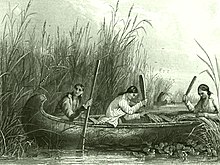Wild rice
The former, though now domesticated and grown commercially, is still often gathered from lakes in the traditional manner, especially by indigenous peoples in North America; the latter was also used extensively in the past.[16][17] Tribes that are recorded as historically harvesting Zizania aquatica are the Dakota, Menominee, Meskwaki, Ojibwe, Cree, Omaha, Ponca, Thompson, and Ho-Chunk (Winnebago).[2] The swollen crisp white stems of Manchurian wild rice are grown as a vegetable, popular in East and Southeast Asia.[citation needed] Wild rice is relatively high in protein, the amino acid lysine and dietary fiber, and low in fat.[24] Anthropologists since the early 1900s have focused on wild rice as a food source, often with an emphasis on the harvesting of the aquatic plant in the Lake Superior region by the Anishinaabe people, also known as the Chippewa, Ojibwa and Ojibwe.[26]: 1019 Wild rice's social and economic importance has continued into present times for the Anishinaabe and other north woods tribal members despite the availability of more easily obtainable food sources.Early ethnographic reports, tribal accounts and historical writings also inform archaeological research in the human use of wild rice.For example, geographer and ethnologist Henry Schoolcraft in the mid-1800s wrote about depressions in the ground on the shore of a lake with wild rice growing in the water.[26]: 1067 These jigging pits are part of the husking needed to process wild rice, and archaeologists see these holes in the soil stratigraphy in archaeological excavations today.[28] Despite the close association of the Anishinaabe and wild rice today, indigenous use of this food for subsistence also predates their arrival in the Lake Superior region.The Anishinaabe today were part of a larger Algonquian group who left eastern North America on a centuries-long journey to the west along the St. Lawrence River and Great Lakes.The Anishinaabe migration story details a vision to follow a giant clam shell in the sky to a place where the food grows on the water.[29] Archaeological and other scientific investigations have focused on the prehistoric exploitation of wild rice by humans, including: 1) the Anishinaabe, 2) so-called proto-Anishinaabe who may have later transformed into this culture from an earlier form, 3) other indigenous groups who exist today such as the Sioux people, and 4) archaeological-categorized cultures from the Initial and Terminal Woodland periods whose living lineages today are more difficult to identify.[30] But a more precise dating of the antiquity of human use of wild rice and the appearance of the plant itself in lakes and streams have been the subjects of continuing academic debates.[32] After European contact, indigenous wild rice processors generally abandoned ceramic vessels in favor of metal kettles.Furthermore, all excavation levels that solely contained ceramics only used during the Initial Woodland period (known as Laurel pottery complex) also included wild rice seeds.





USLHT ZizaniaPorteresiaFritillaria camschatcensisWild rice (disambiguation)Scientific classificationPlantaeTracheophytesAngiospermsMonocotsCommelinidsPoalesPoaceaeOryzoideaeOryzeaeFassettGriseb.Turcz.Zizania palustrisZizania texanaHitchc.SynonymsgrassesNorth AmericaOryza sativaOryza glaberrimastreamsdabbling ducksannual plantGreat LakesBoreal ForestNorthern OntarioAlbertaSaskatchewanManitobaCanadaMinnesotaWisconsinMichiganSaint Lawrence RiverFloridaAtlanticZ. texanaperennial plantSan Marcos RiverZ. latifoliaextinctionpollutionManchurianNew Zealandinvasive speciesNative AmericanscanoeingthreshgerminateAmerican Museum of Natural HistoryOjibweWhite Earth Nationrights of naturelegal personhoodEnbridge Line 3 oil sands pipelineOmǣqnomenēwakMahnomen, MinnesotaMenomonie, WisconsinCaliforniastate grainpaddy fieldsHungaryAustraliaChinesepinyinvegetableSoutheast Asiasmut fungusUstilago esculentapropagatedHarvestEnergyCarbohydratesDietary fiberProteinVitaminsVitamin A equiv.luteinzeaxanthinThiamine (B1)Riboflavin (B2)Niacin (B3)Vitamin B6Folate (B9)Vitamin CVitamin EMineralsCopperMagnesiumPotassiumSodiumthe National Academiesamino acidlysineglutenthiaminriboflavinniacinfolateAnishinaabeHenry SchoolcraftBibcodeWayback MachineSkyhorse PublishingMPR NewsUnited States Food and Drug AdministrationCerealspseudocerealsBarleyJob's tearsMaize (Corn)MilletsSorghumTriticaleWheat (Triticum)KhorasanRed FifeNorin 10WinterEinkornPolygonaceae